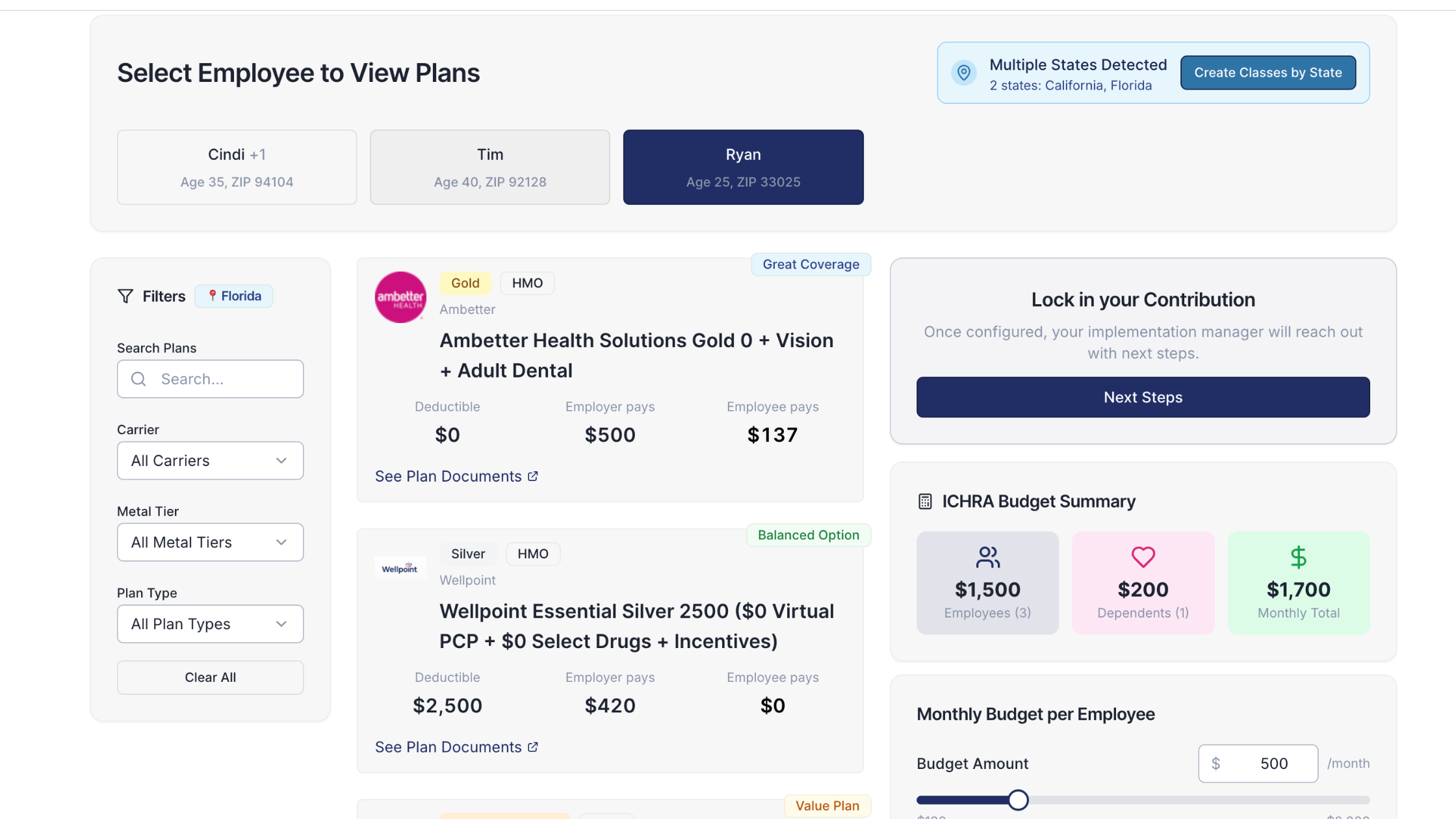What are PPO Health Plans?

If you’re weighing health benefits for your team or advising clients on plan design, chances are you’ve come across PPO health insurance plans. Put simply, a Preferred Provider Organization plan gives members a wide choice of doctors and hospitals, with the flexibility to get care both in and out of the network, usually without referrals.
PPO health insurance plans are designed for people who want freedom to choose providers and direct access to specialists. For employers and brokers, this structure can satisfy a diverse workforce that values choice, convenience, and a broad national footprint.
How PPO Health Insurance Plans Work
A preferred provider organization builds a network of doctors, hospitals, labs, and clinics that agree to provide care at negotiated rates. Members get the best prices when they stay in-network and still have coverage when they go out-of-network, though costs are higher.
PPO Network
- PPO networks include primary care doctors, specialists, hospitals, urgent care centers, labs, and other facilities.
- These providers accept discounted, pre-negotiated rates for services. Those discounts translate into lower costs for members who stay in-network.
- Members can also see out-of-network providers. The plan still covers a portion of the bill, but the member pays more and may face a separate, higher out-of-network deductible.
In-Network vs. Out-of-Network Costs
In-network care usually comes with:
- Lower deductibles and coinsurance
- Predictable copays for office visits and common services
- Streamlined billing, since providers bill the plan directly
Out-of-network care often includes:
- A higher deductible and higher coinsurance
- Possible balance billing if the provider charges above the plan’s allowed amount
- More paperwork, since members may need to submit claims themselves
Premiums, Deductibles, Copays, and Coinsurance
- Premiums are the monthly amount paid to keep coverage active. PPO premiums are typically higher than more restrictive plan types in exchange for added flexibility.
- The deductible is the amount a member pays before the plan starts sharing costs for covered services.
- Copays are flat fees for common services, like a primary care visit or a prescription.
- Coinsurance is a percentage of the allowed charge that the member pays after meeting the deductible.
PPO Health Plan Benefits
PPO health plan benefits center on flexibility, access, and convenience. Members appreciate that they can see a specialist without a referral and that the network spans many providers across regions.
Freedom to Choose PPO Network Doctors
Members can see any provider in the network and usually do not need to select a primary care physician. If a favorite doctor isn’t in-network, the member can still see them with out-of-network coverage. This is a key reason PPO network doctors appeal to employees who value continuity of care.
No Referrals Needed for Specialists
Most PPOs do not require a referral to see a specialist. Members can book directly with dermatologists, cardiologists, orthopedists, and other specialists. That saves time and reduces the number of appointments needed to get to the right care.
Broad and Practical PPO Insurance Coverage
PPO insurance coverage generally includes:
- Preventive care and annual checkups
- Primary and specialty care
- Diagnostic tests and imaging
- Urgent care and emergency services
- Hospitalization and outpatient surgery
- Pregnancy and newborn care
- Mental health and substance use disorder services
- Prescription drugs
Plan details vary by carrier and state. It’s always smart to review a plan’s Summary of Benefits and Coverage to confirm specifics.
PPO vs. HMO, EPO, and HDHP
Understanding differences among common plan types helps employers and brokers match benefits to workforce needs.
- HMO (Health Maintenance Organization): Usually requires members to choose a primary care physician and get referrals for most specialists. Out-of-network care isn’t covered except for emergencies. Premiums are often lower than PPOs.
- EPO (Exclusive Provider Organization): No referrals for specialists, similar to PPO, but no coverage for out-of-network care except emergencies.
- HDHP (High-Deductible Health Plan): Can be HMO, EPO, or PPO in structure, but with a higher deductible and eligibility for a Health Savings Account (HSA). Good for cost-conscious members who are comfortable with higher up-front risk.
PPO health insurance plans typically cost more than HMOs but offer wider provider choice and out-of-network coverage that many employees value.
When a PPO Makes Sense for Employers and Brokers
For brokers advising multi-state employers or fast-growing teams, PPO health plan benefits can be a strong fit. Consider a PPO when your workforce:
- Spans multiple regions and needs national or multi-state access
- Has high provider loyalty or ongoing specialty care
- Travels frequently for work and benefits from broad networks
- Wants direct access to specialists without referrals
PPOs can also support talent strategy. Offering flexible coverage shows you respect employee preferences, which can enhance retention and recruiting, even when premiums run higher than more restrictive plans.
How PPOs Fit With ICHRA
Many employers want the flexibility of PPO network doctors paired with more predictable costs. That’s where an Individual Coverage Health Reimbursement Arrangement (ICHRA) can help.
What Is ICHRA
With ICHRA, employers set a tax-free monthly allowance. Employees use that allowance to buy their own individual health insurance that best fits their needs: PPO, HMO, EPO, or another plan type. Employers control spending, and employees get true choice.
Why Brokers Pair PPOs With ICHRA
- Flexibility: Employees can choose PPO insurance coverage if they want wide provider access.
- Personalization: Each employee picks a network that fits their doctors, budget, and care needs.
- Portability: Coverage is tied to the person, not the group plan, making transitions smoother.
Venteur’s Role
Venteur’s platform is built for ICHRA from the ground up. Employers set budgets, employees shop confidently, and brokers streamline operations. Our guidance helps employees compare plan types, including PPO health insurance plans, so they can find the right balance of provider access and total cost.
Practical Tips for Using a PPO Wisely
Check Network Status Before You Book
- Confirm that your doctor or hospital is in-network. Office staff can check, but the plan’s provider directory is typically the best source.
- If a provider is out-of-network, ask about cash-pay discounts or whether there’s a comparable in-network option.
Understand Your Costs Up Front
- Look up the plan’s deductible, coinsurance, and copays for the service you need.
- Ask for a cost estimate or prior authorization when appropriate, especially for imaging or elective procedures.
Use Preventive Care
Annual checkups and many screenings are covered at no additional cost when in-network. Taking advantage of preventive benefits can catch issues early and reduce long-term costs.
Keep Records for Out-of-Network Care
If you go out-of-network, request an itemized bill and keep copies. You may need to submit a claim form along with the bill for reimbursement based on plan rules.
Final Thoughts for Employers and Brokers
PPO health insurance plans offer wide provider access, no-referral specialist visits, and coverage that can follow employees across regions. That flexibility is why many organizations still include a preferred provider organization option in their benefits lineup. For employers seeking more control over budgets without sacrificing choice, pairing PPO access with ICHRA can align costs with employee preferences. Venteur is here to help you design, implement, and support this approach so that your team can choose confidently and your company can manage spend predictably.
If you’re considering next steps, start with your team’s provider preferences, then weigh network breadth and total cost of care, not just premiums. That framework makes PPO decisions clearer and helps you put the right options in front of your people.
You got questions, we got answers!
We're here to help you make informed decisions on health insurance for you and your family. Check out our FAQs or contact us if you have any additional questions.
No. You can usually see any in-network provider without naming a primary care physician first. This is a core feature of a preferred provider organization.
Typically yes. You’re paying more each month for broader provider choice and out-of-network coverage, though exact premiums vary by carrier and market.
Most PPOs include prescription benefits, but the details depend on the specific plan. Always check the formulary and cost tiers for your medications.
- You can continue care out-of-network, but you’ll likely pay more.
- Ask the plan about transition-of-care options for ongoing treatment.
- The plan reimburses a portion of the “allowed amount,” and you pay the remainder.
- Some providers may require you to pay upfront; then you submit a claim for reimbursement.
Explore more related content
What is Venteur
Explore the best human-first Health Insurance platform
Simple, personalized health benefits
Sign up in minutes, define your contribution, and let your employees choose the health plan that works right for them
Integrations to make everything run smoothly
We'll connect with your payroll and finance systems to make deductions and premium payments seamless
Easy onboarding and off-boarding
In just a few clicks, add your roster and make updates on the fly. We'll handle it from there.
Venteur Certified Brokers to help your employees pick the right plan
Our trusted brokers ensure the best outcomes for employees and employers by unlocking health savings and providing unrivaled plan options.
AI-powered plan recommendations to give you confidence while you shop
Backed by 30 years of healthcare data, Venteur’s AI helps employees compare and choose the best plan for their unique situation.
Compliance and reporting because no-duh!
Venteur manages plan administration, reporting, and compliance so you can focus on growing your business.


